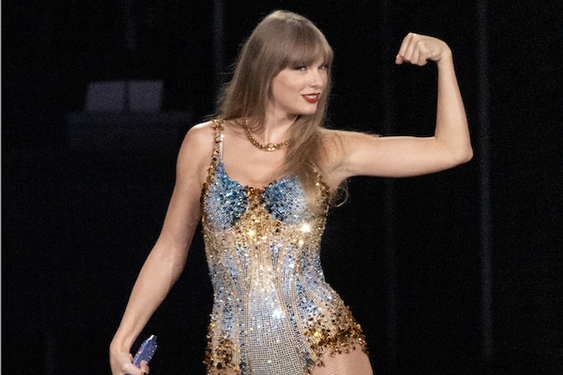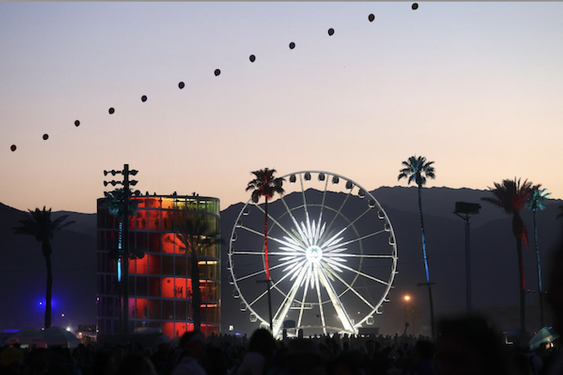What makes for a truly magical moment at a concert?
What makes that moment unforgettable, regardless of whether you are in the front row or back, listening to a recording, or watching in a movie theater, on TV or on a phone?
Depending on your age and aesthetic preferences, the answers could range from Jim Hendrix boldly reinventing "The Star Spangled Banner" at the 1969 Woodstock festival or Michael Jackson moonwalking for the first time at the televised "Motown 25th Anniversary Special" in 1983 to Prince blazing through "Purple Rain" — during a downpour — at the 2007 Super Bowl halftime show.
Or maybe it was Duke Ellington Orchestra star Paul Gonsalves soaring in his monumental, 27-chorus tenor sax solo at the 1957 Newport Jazz Festival, or the members of Nine Inch Nails taking to the Woodstock 1994 stage covered head to toe in mud, or Beyonce segueing from "Lift Every Voice And Sing" into "Formation" at the 2018 Coachella festival in Indio, California.
With the battle against COVID-19 finally starting to gain traction, the resumption of live events is finally underway — albeit with social distancing and reduced-attendance capacities. As anticipation builds for a full-fledged return to concerts and festivals, now is an opportune time to reflect on the magical moments that only a live, real-time music can produce.
Of course, entire concerts can me magical. Picking my favorite concerts is a challenge, thanks to James Brown, Miles Davis, Jill Scott, the Rolling Stones and many others. But for today's article, I am focusing on singularly special moments from concerts, moments that are so indelible they seem almost as vivid now as when the concerts took place.
Here are eight of the many such moments I have been fortunate enough to experience in my decades of avid concertgoing.
Adele
San Diego State University Open Air Theater, Aug. 18, 2011
Adele was just 23 and had not yet become a queen of the Grammy Awards when she performed her exhilarating concert for a sold-out audience at SDSU. But the golden-voiced English singer and songwriter commanded the stage from start to finish, interspersing her songs with animated off-the-cuff observations, amusing anecdotes, a winning laugh and several f-bombs that sounded completely natural, not affected.
Yet, while Adele delivered rapturous versions of "Someone Like You," "Lovesong" and "Rolling in the Deep," she soared highest with her deeply felt version of Bonnie Raitt's timeless 1991 ballad, "I Can't Make You Love Me." An exquisitely tender chronicle of heartbreak, it became even more poignant as Adele — whose best self-penned songs underscore her own failed romances — infused each note with passion, grace and a knowing sense of emotional loss.
Ray Charles
Humphreys Concerts by the Bay, Aug. 13, 1986
Midway through Ray Charles' typically mesmerizing performance at the intimate outdoor venue on San Diego's Shelter Island, a large egret swooped down from the sky. As Charles launched into the lush Leon Russell ballad, "A Song for You," the egret began loudly bedding down in a palm tree located just to the side of the stage where the fabled blind singer and pianist was performing with his band.
Unaware of the source of this disruption, Charles angrily assumed he was being heckled and abruptly stopped the song. He then scolded the audience, saying: "I'm sorry, ladies and gentlemen, but I don't have to take that from anyone." Charles' tour manager then dashed on stage and whispered to him that he was the victim of fowl, not foul, manners.
Charles broke into a broad smile. Without missing a beat, he cued his band and resumed "A Song for You." The egret was silent as Charles intoned the lyrics: I've acted out my life in stages/ With 10,000 people watching/ But we're alone now/ And I'm singing this song to you.
Kendrick Lamar
Mattress Firm Amphitheatre, Chula Vista, California, May 13, 2018
Less than a month after becoming the first hip-hop artist in history to be awarded a Pulitzer Prize in music, Kendrick Lamar took a triumphant victory lap at his aptly named "Championship Tour" concert in San Diego. There were a number of high points, including his engrossing performances of "DNA," "King Kunta" and "Swimming Pools (Drank)."
But the defining moment of the evening came with "Alright," a song inspired by the legacy of slavery and by Lamar's trip to South Africa, where he visited Nelson Mandela's former prison cell on Robben Island. Its refrain — We gon' be alright — has become a rousing rallying cry at Black Lives Matter marches everywhere, a chant for hope in troubled times.
As Lamar performed "Alright," thousands of his fans jumped up and down in time to its percolating groove and chorused with him in unison. It was a potent reminder of how music can simultaneously unify and uplift, entertain and educate, capture a moment and transcend it.
King Crimson
Humphreys Concerts by the Bay, June 19, 2017
I was a teenager when I first saw King Crimson live, back in 1973 at the Santa Monica Civic Auditorium, and I can recall that concert almost as clearly as this mighty progressive-rock band's performance in 2017. Founder and guitarist Robert Fripp is the only original member still on board and the eight-man lineup he led at Humphreys was a marvel of dazzling percussive invention by drummers Pat Mastelotto, Gavin Harrison and Jeremy Stacey.
But what stands out for me most was a moment that occurred during the final encore, "21st Century Schizoid Man," a blistering 1969 classic that inspired everybody from Jimi Hendrix and Kurt Cobain to the members of Tool. King Crimson's version at Humphreys was suitably combustible but contained one moment so witty and surprising that it still makes me smile now.
In the middle of his suitably schizoid tenor sax solo, Mel Collins playfully quoted the main melody from the 1939 Duke Ellington/Billy Strayhorn jazz staple "Take the 'A' Train." Collins' musical homage lasted no more than 10 seconds and was delightfully incongruous. But it worked, linking two pieces of completely disparate music recorded 30 years apart, then bringing them both into a new century.
It was the most unexpected — and unexpectedly delightful — musical quotation I had heard in, oh, about 19 years. That was how long ago the beyond-the-edge Rova Saxophone Quartet deftly inserted the reharmonized main riff from Jeff Beck's "Freeway Jam" into the middle of a freewheeling improvisation at Rova's 1998 Spruce Street Forum gig.
Prince and Stevie Wonder
Ninth annual Rhythm & Blues Foundation Pioneer Awards, Imperial Ballroom, Sheraton Towers Hotel, New York, Feb. 26, 1998
The lineup at this now sadly defunct awards show was beyond stellar. It included Gladys Knight & The Pips, The O'Jays, former Ray Charles sax dynamo David "Fathead" Newman, Screamin' Jay Hawkins, Ernie K-Doe, The Five Satins, Kaye Weston, Tyrone Davis and several other honorees.
Each performed with infectious vim and vigor. But what I remember most about that intensely soulful night is two legends who did not take the stage: Prince and Stevie Wonder. They arrived together in near-darkness, shortly after things got underway, and were seated directly in front of me.
The contrast between them was startling. Prince did not applaud or cheer once. He did not tap his feet or bob his head. In fact, he barely moved for two hours. Wonder, conversely, was so enthusiastic as he called out words of encouragement and constantly danced in his chair that he almost seemed to levitate at times.
I have witnessed Wonder have a similar impact on audiences at several of his concerts. Why Prince, who died five years ago last month, was so unresponsive while Wonder joyfully exuded so much excitement is a mystery. But if you ever are lucky enough to be seated behind Stevie Wonder at a concert, you may have a hard time watching anyone but him.
Sting and Joni Mitchell
Wiltern Theater, Los Angeles, Feb. 4, 1991
Joni Mitchell was in the audience, not on stage, when Sting brought his "The Soul Cages Tour" to LA 30 years ago. But by sheer great fortune, Mitchell was seated on a center aisle directly behind me. As a result, when Sting and his ace band performed such Police classics as "Message in a Bottle," "Every Breath You Take" and "Every Little Thing She Does is Magic," I was treated to a musical bonus no amount of money could buy.
Namely, the incandescent sound of Mitchell singing harmonies — word for word — into the back of my head. And when Sting sang the Bill Withers' gem "Ain't No Sunshine," Mitchell's radiant vocals stole the show, at least for this lucky listener.
Neil Young
Desert Trip festival, Empire Polo Club, Indio, Oct. 15, 2016
There was much to savor during the performance by Neil Young at the second weekend of the Desert Trip festival, which took place at the same Indio location where the annual Coachella and Stagecoach festivals are held. He opened with a tender solo version of his 1970 classic, "After the Goldrush," and concluded 19 songs later with a galvanizing "Rockin' in the Free World."
But the peak came when Young began to perform his lilting ballad, "Harvest Moon," at exactly the moment a luminous harvest moon became visible rising in the sky behind the stage. It was a stunning special effect, one that suggested either very good luck or expert planning. Either way, the unique combination of sight and sound was priceless.
Honorable mention: During the first of Radiohead's two June 2006 San Diego concerts at Embarcadero Marina Park South, a rocket was launched from Vandenberg Air Force Base. The rainbow-like plumes in the rocket's jet stream painted a vivid image as the sun began to set. It was a stunning special effect that no amount of money in any rock band's budget could ever cover.
Kenny Barron and Charlie Haden
Athenaeum Jazz at Neurosciences Institute, April 4, 1998
Once in a very blue moon, a magical moment at a concert can prove transformative for just a single audience member — even if only after the fact — at the exact same time that single audience member is disrupting the enjoyment of many other attendees. That is precisely what transpired during the second half of a sublime duo performance 23 years ago by two jazz luminaries, bassist Charlie Haden and pianist Kenny Barron.
A male concertgoer in an aisle seat near the stage dozed for more than a minute during Haden's supple solo on "Cherokee" and nearly as long two numbers later during Barron's show-closing "First Song." I was seated about 10 rows back on the opposite side and did not know the very distracting loud, low buzzing sound reverberating through the hall was someone snoring. After the concert, a friend seated directly behind the snoozing man filled me in.
Four days later, I recounted the incident in my weekly Union-Tribune column, Pop Beat, in an item entitled "Jazz? Or Jazzzz?" In response, another attendee at the concert, now-retired La Jolla doctor Don Wolochow, wrote a letter that we published. He offered a diagnosis "from a distance" that the snoring man suffered from obstructive sleep apnea.
The man read Wolochow's letter and went to a sleep specialist who confirmed the man's previously undiagnosed condition. The man then phoned Wolochow and profusely thanked him. For the snorer, Haden and Barron's concert and Wolochow's subsequent diagnosis — thanks to the venue's pristine acoustics — was not just magical, but transformative.
___
(c)2021 The San Diego Union-Tribune
Visit The San Diego Union-Tribune at www.sandiegouniontribune.com
Distributed by Tribune Content Agency, LLC.




